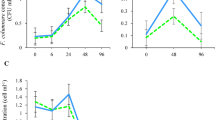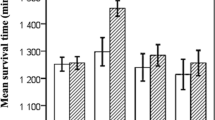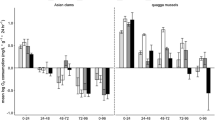Abstract
The Lost River sucker (Deltistes luxatus) is a federally listed, endangered species inhabiting the hypereutrophic waters of Upper Klamath Lake in southern Oregon, USA. High pH (≥10) and elevated ammonia concentrations (≥1 mg NH3-N/L) often occur during blooms of cyanobacteria (Aphanizomenon flos-aquae) in the lake, with major fish kills sometimes following a mid- or late-summer “crash” of the cyanobacterial population. Previous histopathology analyses and bacterial sampling indicated that infections of the pathogenic bacterium Flavobacterium columnare might contribute to the fish kills. We hypothesized that prior exposure to adverse water quality conditions increases the susceptibility of Lost River suckers to F. columnare infections. To test this, we exposed juvenile Lost River suckers to four sublethal ammonia concentrations at pH 9.4 for 62 d. On day 31, fish in half of the aquaria were exposed to F. columnare. As expected, survival of the Lost River suckers decreased in aquaria inoculated with F. columnare. Ninety-four percent of the fish that died were infected by F. columnare in the gills, kidney, or skin, whereas none of the survivors or unexposed control fish was infected. However, contrary to our hypothesis, survival of the fish exposed to F. columnare increased significantly (p < 0.05) as unionized ammonia concentrations increased. Our results suggest that complex interactions can complicate prediction of the responses of fish to concurrent chemical stressors and bacterial pathogens.


Similar content being viewed by others
Explore related subjects
Discover the latest articles, news and stories from top researchers in related subjects.References
Anacker RL, Ordal EJ (1959) Studies on the myxobacterium Chondrococcus columnaris. I. Serological typing. J Bacteriol 78:25–32
APHA (American Public Health Association), AWWA (American Water Works Association), WEF (Water Environment Federation) (1995) Standard methods for the examination of water and wastewater, 19th edition. American Public Health Association, Washington, DC
Bertolini JM, Rohovec JS (1992) Electrophoretic detection of proteases from different Flexibacter columnaris strains and assessment of their variability. Dis Aquat Org 12:121–128
Brockway DR (1950) Metabolic products and their effects. Progr Fish-Cultur 12:127–129
Coots M (1965) Occurrences of Lost River sucker, Deltistes luxatus (Cope), and shortnose sucker, Chasmistes brevirostris (Cope), in northern California. Calif Fish Game 51:68–73
Decostere A, Haesebrouck F, Turnbull JF, Charlier G (1999a) Influence of water quality and temperature on adhesion of high and low virulence Flavobacterium columnare strains to isolated gill arches. J Fish Dis 22:1–11
Decostere A, Ducatelle R, Haesebrouck F, Van Driessche E, Charlier G (1999b) Characterization of the adhesion of Flavobacterium columnare (Flexibacter columnaris) to gill tissue. J Fish Dis 22:465–474
Emerson K, Russo RC, Lund RE, Thurston RV (1975) Aqueous ammonia equilibrium calculations: effect of pH and temperature. J Fish Res Board Can 32:2379–2383
Ferguson HW (1989) Systemic pathology of fish: a text and atlas of comparative tissue responses in diseases of teleosts. Iowa State University Press, Ames, IA
Gerhardt P (ed) (1981) Manual of methods for general bacteriology. American Society for Microbiology, Washington, DC
Gona O (1979) Mucous glycoproteins of teleostean fish: a comparative histochemical study. Histochemistry 11:709–718
Griffin BR (1991) Characteristics of a chondroitin AC lyase produced by Cytophaga columnaris. Trans Am Fish Soc 120:391–395
Griffin BR (1992) A simple procedure for identification of Cytophaga columnaris. J Aquat Anim Health 4:63–66
Hawke JP, Thune RL (1992) Systemic isolation and antimicrobial susceptibility of Cytophaga columnaris from commercially reared channel catfish. J Aquat Anim Health 4:109–113
Hibiya T (1982) An atlas of fish histology. Gustav Fischer Verlag, New York, NY
Holt RA, Amandi A, Rohovec JS, Fryer JL (1989) Relation of water temperature to bacterial cold-water disease in coho salmon, Chinook salmon, and rainbow trout. J Aquat Anim Health 1:94–101
Holt RA (2001) Laboratory challenges with the bacterial pathogen, Flavobacterium columnare and infection of juvenile Lost River suckers (Deltistes luxatus) during their exposure to sublethal ammonia concentrations at pH 9.5. Report submitted to the U.S. Fish and Wildlife Service, Klamath Falls, OR
Humason GL (1979) Animal Tissue Techniques. Fourth Edition. W.H. Freeman and Company, San Francisco, CA
Kann J (1998) Ecology and water quality dynamics of a shallow hypereutrophic lake dominated by cyanobacteria (Aphanizomenon flos-aquae). Ph.D. Dissertation, University of North Carolina, Chapel Hill, NC
Lease HM, Hansen JA, Bergman HL, Meyer JS (2003) Structural changes in gills of Lost River suckers exposed to elevated pH and ammonia concentrations. Comp Biochem Physiol Part C 134:491–500
Lewis PA, Klemm DJ, Lazorchak JM, Norberg-King TJ, Peltier WH, Heber MA (eds) (1994) Short-term methods for estimating the chronic toxicity of effluents and receiving waters to freshwater organisms, 3rd ed. EPA-600-4-91-002, U.S. Environmental Protection Agency, Environmental Monitoring Systems Laboratory, Cincinnati, OH
Meyer JS, Hansen JA (2002) Subchronic toxicity of low dissolved oxygen concentrations, elevated pH, and elevated ammonia concentrations to Lost River suckers. Trans Am Fish Soc 131:656–666
Modra H, Svobodova Z, Kolarova J (1998) Comparison of differential leukocyte counts in fish of economic and indicator importance. Acta Vet Brno 67:215–226
Moritomo T, Suerhiro M, Kodama H, Amenori T, Ohba S, Nemoto H, Hasegawa A, Yoshida H (1999) A new method for the identification and enumeration of carp granulocytes. Fish Pathol 34(2):85–86
Pacha RE, Ordal EJ (1970) Myxobacterial diseases of salmonids. In: S.F. Snieszko (ed) A symposium on diseases of fishes and shellfishes. Special Publication No. 5, American Fisheries Society, Washington, DC, pp. 243–257
Perkins D, Scoppettone GG, Buettner M (2000a) Reproductive biology and demographics of endangered Lost River and shortnose suckers in Upper Klamath Lake, Oregon. Project Report, U.S. Geological Survey, Western Fisheries Science Center, Reno, NV
Perkins DL, Kann J, Scoppettone GG (2000b) The role of poor water quality and fish kills in the decline of endangered Lost River and shortnose suckers in Upper Klamath Lake. U.S. Geological Survey, Biological Resources Division Report to U.S. Bureau of Reclamation, Klamath Falls, OR
Rombough PJ (1999) The gill of fish larvae. Is it primarily a respiratory or an ionoregulatory structure? J Fish Biol 55:186–204
Smart G (1976) The effect of ammonia exposure on gill structure of the rainbow trout (Salmo gairdneri). J Fish Biol 8:471–475
Snyder DT, Morace JL (1997) Nitrogen and phosphorus loading from drained wetlands adjacent to Upper Klamath and Agency Lakes, Oregon. U.S. Geological Survey Water-Resources Investigations Report 97-4059, Portland, OR
USFWS (U.S. Fish, Wildlife Service) (1988) Endangered and threatened wildlife and plants: shortnose and Lost River suckers, Houghton’s goldenrod and Pitcher’s thistle: final rules. Federal Register 53:27130–27134
USFWS (U.S. Fish and Wildlife Service) (1993) Recovery plan: Lost River sucker (Deltistes luxatus) and shortnose sucker (Chasmistes brevirostris). U.S. Department of the Interior, Fish and Wildlife Service, Portland, OR
USFWS (U.S. Fish and Wildlife Service) (2002) Biological/conference opinion regarding the effects of operation of the U.S. Bureau of Reclamation’s proposed 10-year operation plan for the Klamath Project and its effect on the endangered Lost River sucker (Deltistes luxatus), endangered shortnose sucker (Chasmistes brevirostris), threatened bald eagle (Haliaeetus leucocephalus) and proposed critical habitat for the Lost River and shortnose suckers. Prepared by the U.S. Fish and Wildlife Service, Klamath Falls Fish and Wildlife Office, Klamath Falls, OR
Verdouw H, van Echteld CJA, Dekkers EMJ (1978) Ammonia determination based on indophenol formation with sodium salycilate. Water Res 12:399–402
Walters GR, Plumb JA (1980) Environmental stress and bacterial infection in channel catfish, Ictalurus punctatus. J Fish Biol 17:177–185
Weber CI (ed) (1993) Methods for measuring the acute toxicity of effluents and receiving waters to freshwater and marine organisms. Fourth Edition. EPA/600/4-90/027F, U.S. Environmental Protection Agency, Cincinnati, OH
WEST (Western EcoSystems Technology, Inc.), Gulley DD (1994) TOXSTAT® 3.4. Western EcoSystems Technology, Inc., Cheyenne, WY
Written PE, Vilwock W, Renwrantz L (1998) Haematogram of the tilapia Oreochromis niloticus (Cichlidae, Teleostei) and application of a putative phenoloxidase for differentiating between neutrophilic granulocytes and monocytes. Can J Zool 76:310–319
Yasutake WT, Wales JH (1983) Microscopic anatomy of Salmonids: an atlas. Research Publication No. 150, U.S. Fish and Wildlife Service, Washington, DC
Zar JH (1984) Biostatistical analysis. 2nd Edition. Prentice-Hall, Inc., Englewood Cliffs, NJ
Acknowledgments
This research was funded by the Environmental Contaminants Off-Refuge Investigation Program of the U.S. Fish and Wildlife Service through an interagency agreement with the Wyoming Cooperative Fisheries and Wildlife Research Unit of the U.S. Geological Survey, located in the Department of Zoology and Physiology at the University of Wyoming. The Wyoming Department of Game and Fish (WDGF) granted permission to conduct tests with Lost River suckers at Red Buttes Environmental Biology Laboratory. Joe Bobbitt assisted with the design and construction of the experimental system; Connie Boese assisted with chemical analyses; and Scott Collyard helped monitor the experiment. Dave Money (WDGF) advised us on handling the bacteria and disinfecting exposure water and equipment. Larry Dunsmoor (Klamath Tribes Native Fish Hatchery) supplied the propagated juvenile Lost River suckers and he advised us on culturing techniques. This use complied with Subpermit No. KLATRB-9 issued to the Hatchery by the U.S. Fish and Wildlife Service under Regional Blanket Permit No. PRT-702631, allowing use [take] of progeny from experimental breeding for research to assess predation on and physiological tolerances of both shortnose and Lost River suckers to pH, low D.O., temperature, and ammonia. Mark Buettner (Bureau of Reclamation) provided input to the study design.
Author information
Authors and Affiliations
Corresponding author
Rights and permissions
About this article
Cite this article
Morris, J.M., Snyder-Conn, E., Foott, J.S. et al. Survival of Lost River Suckers (Deltistes luxatus) Challenged with Flavobacterium columnare During Exposure to Sublethal Ammonia Concentrations at pH 9.5. Arch Environ Contam Toxicol 50, 256–263 (2006). https://doi.org/10.1007/s00244-004-0194-x
Received:
Accepted:
Published:
Issue Date:
DOI: https://doi.org/10.1007/s00244-004-0194-x





